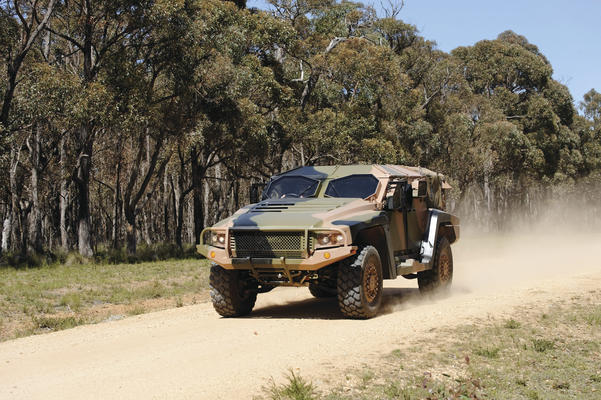With pilot production getting underway later this year at Thales Australia’s Bendigo facility, Army’s Hawkei light protected mobility vehicle (PMV) will soon gain a higher profile.
Julian Kerr | Sydney
Yet few admirers of the Hawkei’s distinctive styling – honed by a designer who once worked for Ferrari – will be aware that the interior is equally impressive, boasting as it does a built-in Integral Computing System (ICS) that allows information from numerous disparate systems to be presented on a common screen.
As noted by Major General Gus McLachlan, Head of Army Modernisation, “this represents the move of the land platform into the era of the ‘glass cockpit’ in which all the functions of the vehicle and communications and information systems capability are managed through a single common crew interface”. See his From the Source interview for more on this.
Essentially, the ICS is a computing infrastructure that is based on the UK Defence Standard 23-09 Generic Vehicle Architecture (GVA). This defines a single, standard digital electronic and electrical architecture, and addresses the need for a standardised human-machine interface (HMI).
“The ICS is the human/machine interface that defines how that information is presented through common screens.”
“The ICS provides resources on which you can run applications, whether they are C4I applications or other systems that are needed to fulfil a mission,” Sam Keayes, Vice President Secure Communications and Information Systems for Thales Australia explained to ADM. “You can plug in your external and internal communications system, your weapons system, your network management system, your vehicle Health and Usage Monitoring System (HUMS), micro UAVs, Unmanned Ground Systems (UGS), and anything else you like.
“The ICS is the human/machine interface that defines how that information is presented through common screens, and at a technical level it’s the core services and software to allow all those things to be managed and the data prioritised and distributed”.
Thales says the Hawkei concept from its initiation had assumed that the design would include an ICS or something very similar.
Lessons had been learnt from Thales UK and its work with the UK’s Foxhound protected patrol vehicle; from Thales Netherlands in the integration to the CIS of the SOTAS intercom system with the ICS, and from other major vehicle integration programs undertaken by Thales in Europe, the Middle East and elsewhere.
However, the design and development of the ICS and the application of the GVA deskpad into the Hawkei architecture had been the responsibility and the achievement of Thales Australia.
 One of the test vehicles at Defence's Monegeetta proving ground. Credit: Thales Australia.
One of the test vehicles at Defence's Monegeetta proving ground. Credit: Thales Australia.
“The standards are published so the art is inputting the system together and integrating it with the platform itself,” Keayes said.
“The objective was ensuring the ICS and the platform went together absolutely seamlessly so as to achieve the best size/weight/power characteristics as well as providing the required information.
”The four-door Hawkei Command variant has .35 square metres of space between the front and rear seats to accommodate ICS equipment in purpose-designed racks – sufficient for the Hawkei requirement but inadequate for the traditional bespoke approach of different systems requiring their own real estate. GVA power is provided through separate buses, wiring harnesses and battery systems to avoid system interference.
The Command platform will have three displays, one for each seated position less the driver. The two-door variant is designed for one display for the commander (passenger) location.
Bezel buttons across the top of the ICS display provide access to a standard menu of available views. Bezel buttons down each side of the screen trigger various elements which can be drilled into, in order to access information or reconfigure systems while on the move.
“The idea is to present information in a consistent way, but as far as possible not add to the training burden by changing the way existing systems will be presented,” Keayes explained to ADM. “You’ll set different parameters depending on the type of mission. You might want all the individuals in the vehicle to be able to access on their screens the optical view from a remote weapon station. Or you may say no, only the driver and/or the commander of the vehicle is able to access that particular view.
”Benefits of the ICS/GVA approach include rapid technology insertion, whether of a new capability or the replacement of an existing system.
“The team writes the interface software in advance, which then helps enable a very rapid insertion,” Keayes said. “A second point is the customer less locked in to system vendors because the switching costs are relatively light; you’re not building the systems into the vehicle, you’re integrating them into an ICS. This will encourage suppliers to innovate and reduce costs more precisely because of their commercial incentive to deliver ongoing benefits.
“The third, obvious, end-user benefit is the saving in weight and space. There is one set of computers and one set of screens. You don’t have the entire vehicle cluttered with several different screens for integrated systems, several different computing boxes to support those screens.
“You have a single system with a single set of computing power on which the other applications are essentially virtualised and presented to the user on a single GVA screen. And because it’s all common, the training burden is decreased”.
Keayes confirmed that ICS had been included in the unsuccessful General Dynamics/Thales bid for Land 400 Phase 2.
This article first appeared in the September 2016 edition of ADM.




